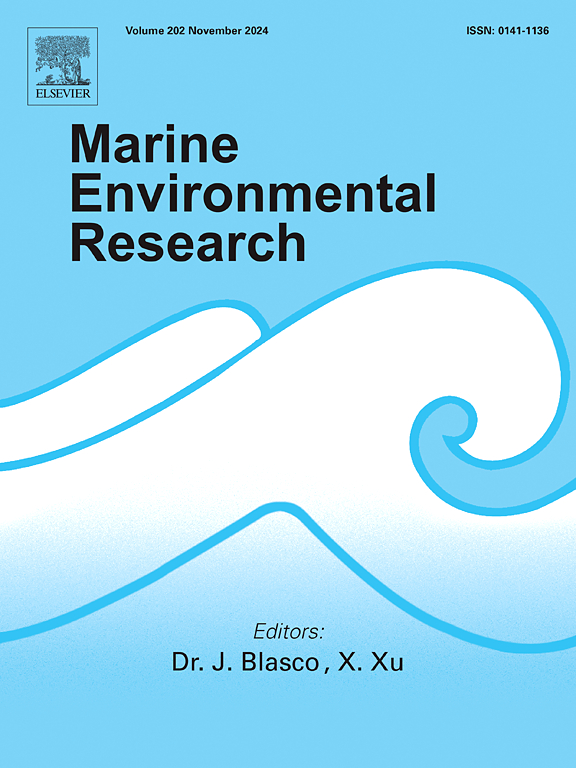Long-term variability analysis of the habitat suitability index for Todarodes pacificus (Japanese common squid) using MODIS-Aqua dataset in the East/Japan Sea, South Korea
IF 3.2
3区 环境科学与生态学
Q2 ENVIRONMENTAL SCIENCES
引用次数: 0
Abstract
The marine fishery resources in South Korea, including Todarodes pacificus (Japanese Common Squid), have experienced significant changes, prompting concern and investigation. This study aimed to develop a habitat suitability index (HSI) model for T. pacificus around South Korea using remote sensing datasets and to analyze its long-term variability. The HSI model was constructed based on the fishing efforts, offering a more accurate representation of habitat distribution for this short-lived species. Key environmental variables−sea surface temperature (SST), sea surface height anomaly (SSHA), chlorophyll-a (Chl-a), and primary productivity (PP)−were identified as critical for the habitat distribution of T. pacificus. The preferred environmental conditions for T. pacificus were found to be 14.64–27.81 °C for SST, 0.32–1.28 mg m−3 for Chl-a, −0.04 to 0.2 m for SSHA, and 346–616 mg C m2 d−1 for PP. Seasonal HSI models empirically derived demonstrating a strong positive correlation with fishery landings (r = 0.8921). Long-term analysis from 2002 to 2020, using Empirical Mode Decomposition (EEMD), revealed a significant decline in HSI in the East/Japan Sea, which corresponded with a decrease in the annual catch of T. pacificus. This decline in HSI and fishery production is likely influenced by long-term environmental changes, such as ocean warming and declining PP, which may alter habitat conditions and resource availability. These findings highlight the importance of sustained ecosystem monitoring and adaptive management strategies for the conservation of T. pacificus. Further studies focusing on the detailed interactions between climate change-induced environmental changes and the physiological and phenological responses of T. pacificus are crucial to fully understand and address its ongoing population shifts.
基于MODIS-Aqua数据集的东/日本海太平洋Todarodes pacificus生境适宜性指数的长期变异性分析
韩国的海洋渔业资源,包括太平洋鱿鱼(Todarodes pacificus)发生了重大变化,引起了人们的关注和调查。本研究旨在利用遥感数据建立韩国周边太平洋柽柽树生境适宜性指数(HSI)模型,并分析其长期变化。HSI模型是基于捕捞努力度构建的,可以更准确地表示这种短命物种的栖息地分布。海洋表面温度(SST)、海面高度异常(SSHA)、叶绿素-a (Chl-a)和初级生产力(PP)是影响太平洋柽柽树生境分布的关键环境变量。结果表明,太平洋t的首选环境条件为:海温14.64 ~ 27.81°C, Chl-a 0.32 ~ 1.28 mg m−3,SSHA - 0.04 ~ 0.2 m, PP 346 ~ 616 mg C m2 d−1。季节HSI模型与渔业登陆量呈正相关(r = 0.8921)。利用经验模态分解(Empirical Mode Decomposition, EEMD)对2002 - 2020年东海/日本海的HSI进行了长期分析,发现HSI显著下降,与太平洋T. pacific ificus的年捕鱼量减少相对应。这种HSI和渔业产量的下降可能受到长期环境变化的影响,例如海洋变暖和PP下降,这可能会改变栖息地条件和资源可用性。这些发现强调了持续的生态系统监测和适应性管理策略对太平洋T.的保护的重要性。进一步研究气候变化引起的环境变化与太平洋柽柳生理和物候反应之间的详细相互作用,对于充分认识和解决太平洋柽柳种群变化具有重要意义。
本文章由计算机程序翻译,如有差异,请以英文原文为准。
求助全文
约1分钟内获得全文
求助全文
来源期刊

Marine environmental research
环境科学-毒理学
CiteScore
5.90
自引率
3.00%
发文量
217
审稿时长
46 days
期刊介绍:
Marine Environmental Research publishes original research papers on chemical, physical, and biological interactions in the oceans and coastal waters. The journal serves as a forum for new information on biology, chemistry, and toxicology and syntheses that advance understanding of marine environmental processes.
Submission of multidisciplinary studies is encouraged. Studies that utilize experimental approaches to clarify the roles of anthropogenic and natural causes of changes in marine ecosystems are especially welcome, as are those studies that represent new developments of a theoretical or conceptual aspect of marine science. All papers published in this journal are reviewed by qualified peers prior to acceptance and publication. Examples of topics considered to be appropriate for the journal include, but are not limited to, the following:
– The extent, persistence, and consequences of change and the recovery from such change in natural marine systems
– The biochemical, physiological, and ecological consequences of contaminants to marine organisms and ecosystems
– The biogeochemistry of naturally occurring and anthropogenic substances
– Models that describe and predict the above processes
– Monitoring studies, to the extent that their results provide new information on functional processes
– Methodological papers describing improved quantitative techniques for the marine sciences.
 求助内容:
求助内容: 应助结果提醒方式:
应助结果提醒方式:


